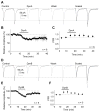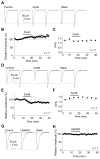Exposure to cocaine alters dynorphin-mediated regulation of excitatory synaptic transmission in nucleus accumbens neurons
- PMID: 21030009
- PMCID: PMC3790254
- DOI: 10.1016/j.biopsych.2010.09.014
Exposure to cocaine alters dynorphin-mediated regulation of excitatory synaptic transmission in nucleus accumbens neurons
Abstract
Background: Dysregulation of excitatory synaptic input to nucleus accumbens (NAc) medium spiny neurons (MSNs) underlies a key pathophysiology of drug addiction and addiction-associated emotional and motivational alterations. Dynorphin peptides, which exhibit higher affinity to κ type opioid receptors, are upregulated within the NAc upon exposure to cocaine administration, and the increased dynorphin-signaling in the NAc has been critically implicated in negative mood observed in cocaine- or stress-exposed animals. Despite such apparent behavioral significance of the NAc dynorphins, the understanding of how dynorphins regulate excitatory synaptic transmission in the NAc remains incomplete.
Methods: We used electrophysiological recording in brain slices to examine the effects of dynorphins on excitatory synaptic transmission in the NAc.
Results: We focused on two key dynorphins, dynorphin A and B. Our current results show that dynorphin A and B differentially regulated excitatory postsynaptic currents (EPSCs) in NAc MSNs. Whereas perfusions of both dynorphin A and B to NAc slices decreased EPSCs in MSNs, the effect of dynorphin A but not dynorphin B was completely reversed by the κ receptor-selective antagonist nor-binaltorphimine. These results implicate κ receptor-independent mechanisms in dynorphin B-mediated synaptic effects in the NAc. Furthermore, repeated exposure to cocaine (15 mg/kg/day via intraperitoneal injection for 5 days, with 1, 2, or 14 days withdrawal) completely abolished dynorphin A-mediated modulation of EPSCs in NAc MSNs, whereas the effect of dynorphin B remained largely unchanged.
Conclusions: Given the quantitatively higher abundance of dynorphin B in the NAc, our present results suggest that the dynorphin B-mediated, κ receptor-independent pathways predominate in the overall effect of dynorphins in cocaine-pretreated animals and potentially in cocaine-induced alterations in mood.
Copyright © 2011 Society of Biological Psychiatry. Published by Elsevier Inc. All rights reserved.
Figures



Similar articles
-
Cascades of Homeostatic Dysregulation Promote Incubation of Cocaine Craving.J Neurosci. 2018 May 2;38(18):4316-4328. doi: 10.1523/JNEUROSCI.3291-17.2018. Epub 2018 Apr 6. J Neurosci. 2018. PMID: 29626166 Free PMC article.
-
Stress and Cocaine Trigger Divergent and Cell Type-Specific Regulation of Synaptic Transmission at Single Spines in Nucleus Accumbens.Biol Psychiatry. 2016 Jun 1;79(11):898-905. doi: 10.1016/j.biopsych.2015.05.022. Epub 2015 Jun 6. Biol Psychiatry. 2016. PMID: 26164802 Free PMC article.
-
Substance P and cocaine employ convergent mechanisms to depress excitatory synaptic transmission in the rat nucleus accumbens in vitro.Eur J Neurosci. 2009 Apr;29(8):1579-87. doi: 10.1111/j.1460-9568.2009.06704.x. Eur J Neurosci. 2009. PMID: 19385993
-
Roles of nucleus accumbens CREB and dynorphin in dysregulation of motivation.Cold Spring Harb Perspect Med. 2013 Feb 1;3(2):a012005. doi: 10.1101/cshperspect.a012005. Cold Spring Harb Perspect Med. 2013. PMID: 23293139 Free PMC article. Review.
-
The role of dopamine, dynorphin, and CART systems in the ventral striatum and amygdala in cocaine abuse.Ann N Y Acad Sci. 1999 Jun 29;877:499-506. doi: 10.1111/j.1749-6632.1999.tb09285.x. Ann N Y Acad Sci. 1999. PMID: 10415667 Review.
Cited by
-
The claustrum-prelimbic cortex circuit through dynorphin/κ-opioid receptor signaling underlies depression-like behaviors associated with social stress etiology.Nat Commun. 2023 Nov 30;14(1):7903. doi: 10.1038/s41467-023-43636-x. Nat Commun. 2023. PMID: 38036497 Free PMC article.
-
Pathway- and Cell-Specific Kappa-Opioid Receptor Modulation of Excitation-Inhibition Balance Differentially Gates D1 and D2 Accumbens Neuron Activity.Neuron. 2017 Jan 4;93(1):147-163. doi: 10.1016/j.neuron.2016.12.005. Neuron. 2017. PMID: 28056342 Free PMC article.
-
The nucleus accumbens in reward and aversion processing: insights and implications.Front Behav Neurosci. 2024 Aug 9;18:1420028. doi: 10.3389/fnbeh.2024.1420028. eCollection 2024. Front Behav Neurosci. 2024. PMID: 39184934 Free PMC article. Review.
-
Prefrontal cortical kappa-opioid receptor modulation of local neurotransmission and conditioned place aversion.Neuropsychopharmacology. 2013 Aug;38(9):1770-9. doi: 10.1038/npp.2013.76. Epub 2013 Mar 29. Neuropsychopharmacology. 2013. PMID: 23542927 Free PMC article.
-
Effects of the κ-opioid receptor on the inhibition of 100 Hz electroacupuncture on cocaine-induced conditioned place preference.Exp Ther Med. 2016 Sep;12(3):1604-1610. doi: 10.3892/etm.2016.3504. Epub 2016 Jul 5. Exp Ther Med. 2016. PMID: 27588082 Free PMC article.
References
-
- Kelley AE. Memory and addiction: shared neural circuitry and molecular mechanisms. Neuron. 2004;44:161–179. - PubMed
-
- Kelley AE. Ventral striatal control of appetitive motivation: role in ingestive behavior and reward-related learning. Neurosci Biobehav Rev. 2004;27:765–776. - PubMed
-
- Meredith GE. The synaptic framework for chemical signaling in nucleus accumbens. Ann N Y Acad Sci. 1999;877:140–156. - PubMed
-
- Hyman SE, Malenka RC, Nestler EJ. Neural mechanisms of addiction: the role of reward-related learning and memory. Annu Rev Neurosci. 2006;29:565–598. - PubMed
Publication types
MeSH terms
Substances
Grants and funding
LinkOut - more resources
Full Text Sources

